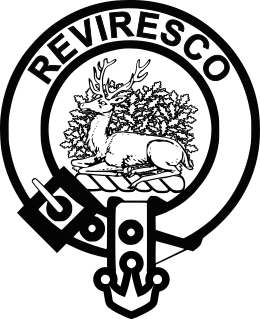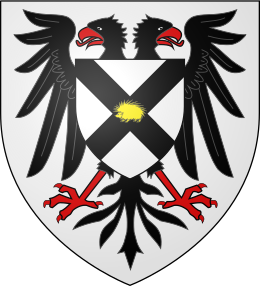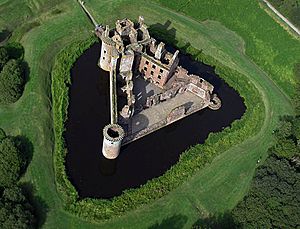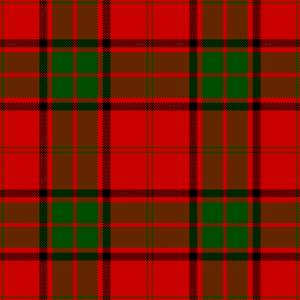Clan Maxwell facts for kids
Quick facts for kids Clan Maxwell |
|||
|---|---|---|---|
| MacSuail | |||

Crest: A stag Proper, attired Argent, couchant before a Holly bush proper.
|
|||
| Motto | Reviresco (I grow strong again). | ||
| Profile | |||
| Region | Lowland | ||
| District | Dumfries | ||
 |
|||
| Clan Maxwell has no chief, and is an armigerous clan | |||
| Historic seat | Caerlaverock Castle | ||
| Last Chief | William Maxwell of Carruchan | ||
| Died | 1863 | ||
|
|||
|
|||
|
|||
|
|||
Clan Maxwell is a historic Scottish clan from the Scottish Lowlands. It is officially recognized as a clan by the Lord Lyon King of Arms. However, because the clan does not currently have a chief, it is known as an armigerous clan. This means it has a coat of arms but no official leader.
Contents
History of Clan Maxwell
Where the Name Maxwell Comes From
The name Maxwell is thought to come from Maccus Well. This was a pool in the River Tweed near Kelso, Scottish Borders. Maccus, or Magnus, was likely a Norse chief. He lived during the time of David I of Scotland.
Sir John Maxwell was a high-ranking official called the Chamberlain of Scotland. He did not have any children. His younger brother, Aymer, took his place. Many branches of the Maxwell family grew from Aymer's sons across south-west Scotland.
The Wars of Scottish Independence
Sir Herbert Maxwell's name appears on the Ragman Rolls in 1296. This means he swore loyalty to Edward I of England. Herbert's son, Eustace Maxwell, held Caerlaverock Castle for the English king.
However, Eustace later joined Robert the Bruce. He fought alongside Bruce at the famous Battle of Bannockburn. This battle was a key moment in Scotland's fight for freedom.
The 15th and 16th Centuries
A descendant of Eustace, another Sir Herbert, became Lord Maxwell around 1440. He gained a seat in the Scottish Parliament. A part of the clan, the Maxwells of Monreith, came from his second son. They later became baronets in 1681.
John Maxwell, 4th Lord Maxwell lost his life at the Battle of Flodden in 1513. This was a major battle between Scotland and England.
The fifth Lord Maxwell worked with King Henry VII of England. In 1526, the Maxwells supported Archibald Douglas, 6th Earl of Angus. They helped defeat the forces of Sir Walter Scott at the Battle of Melrose.
By 1542, King James V of Scotland made Lord Maxwell the Lord Warden of the Marches. This was an important job protecting the border. Also in 1542, Lord Maxwell was captured at the Battle of Solway Moss.
John Maxwell, the seventh Lord Maxwell, was a strong Catholic. This was during the Scottish Reformation, a time of big religious changes. He was involved in plans to help Mary, Queen of Scots become queen again. After Mary was executed in 1587, and after the Spanish Armada was defeated, Lord Maxwell still talked with Philip II of Spain. He hoped to get support for his Catholic beliefs.
However, Lord Maxwell died in 1593 in a conflict with the Clan Johnstone of Lockerbie. This event is known as the Battle of Dryfe Sands. The conflict continued between the clans. The next Lord Maxwell shot Sir James Johnstone. Maxwell's brother, Robert, then became Lord Maxwell. He was made Earl of Nithsdale in 1620.
The 17th Century

Lord Maxwell also had a dispute with the powerful Clan Douglas. This was over the Earldom of Morton, which he believed was his by right. Because of this argument, he was put in Edinburgh Castle in 1607.
After escaping, he shot Sir James Johnstone during a meeting. He then fled to France. He was found guilty of treason while he was away and sentenced to death. When he returned to Scotland in 1612, he was arrested. He was executed in Edinburgh on May 21, 1613.
The 18th Century and Jacobite Risings
The fifth Earl of Nithsdale was a strong supporter of the Jacobite cause. He was captured at the Battle of Preston (1715) during the Jacobite rising of 1715. He was sentenced to death and imprisoned in the Tower of London.
However, with the help of his wife, Winifred, he dressed up as a servant. The couple then escaped to Rome. The Earl died there in 1744.
Maxwell Castles
Many castles have been important to the Clan Maxwell throughout history:
- Caerlaverock Castle was the main home of the Clan Maxwell chiefs.
- Threave Castle was owned by the Clan Maxwell from 1526 to 1640.
- Maxwell Castle was built in 1545. However, it was destroyed by the English in 1570.
- Newark Castle, Port Glasgow was built by the Clan Maxwell in the 15th century.
- Haggs Castle was owned by the Maxwells from 1585 until 1972.
- Pollok House is the home of the Maxwell Baronets of Pollok. It is now very important because it houses the famous Burrell Collection in its grounds.
- Isle Tower
Maxwell Tartan


